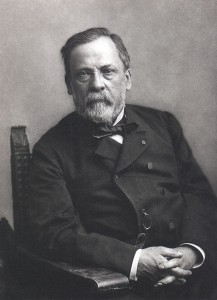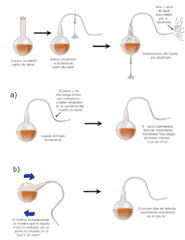Louis Pasteur

Studio portrait of Louis Pasteur.
by Félix Nadar, used under ![]()
Louis Pasteur achieved revolutionary advances in the fields of microbiology and immunology although he began as a chemist (Conn, 1895). He was born on December 27, 1822 in France, and he lived until September 28, 1895 (Anderson, 2006). During his life his dedication to the field of science saved many lives and even French industry (Conn, 1895).
Pasteur attended the Royal College of Besancon and École Normale Supérieure where he received a bachelor’s degree in science followed by a Ph.D in 1847. He began his career as a high school physics teacher and later became a chemistry professor (Anderson, 2006). His studies in chemistry conditioned him to use meticulous experimenting techniques (Louis Pasteur, 1884). It was widely thought that “Pasteur never makes mistakes” most likely due to his attention to detail (Conn, 1895). After studying the chirality of crystals and polarization of light, Pasteur’s studies took him in a different direction (Anderson, 2006). He became fascinated by the fermentation he observed in tartrates of lime. This led him to extensively study fermentation which he concluded was due to the presence of microorganisms (Conn, 1895).
His subsequent experiments in the field of fermentation took him away from the realm of chemistry (Conn, 1895). Although many chemists during that time had also studied it, Pasteur was the first to realize that microorganisms were responsible for fermentation and the spoiling of food items (Anderson, 2006). Other scientists had noted the presence of these microorganisms but not realized their importance (Conn, 1895). Pasteur developed germ theory as a result stating that the growth of living things, or germs, was the cause of spoilage and decay. This led Pasteur to reject spontaneous generation with his S-curved neck flask experiment. In this experiment Pasteur filled flasks with broth, but they had curved necks so that microbes in the air would settle at the bottom of the curve. This created a sterile environment for the broth meaning that no microbes could contaminate it (Anderson, 2006). No growth occurred in the absence of these living organisms, so Pasteur’s careful experiment rejected the previously held belief that life could come from non-life (Conn, 1895).

Experiment with S-curved flasks.
by Alejandro Porto, used under 
In addition to his research Pasteur applied his discoveries to benefit the world (Conn, 1895). He developed the process of pasteurization, heating food products to a temperature high enough to kill the microorganisms present (Anderson, 2006). Also, during the silk-worm crisis in Europe diseased worms ceased to produce adequate silk crippling the industry. Pasteur noticed that the presence of a previously identified organism was the cause of this disease (Conn, 1895). As a result new practices were adopted to kill the parasite and the industry flourished again. Following this accomplishment Pasteur continued the research of Edward Jenner and his smallpox vaccination. Pasteur conducted his own experiment giving a weakened form of cholera to his chickens, and later he discovered that they were then immune to the fully pathogenic disease. This technique helped Pasteur develop a vaccination for rabies in the future (Anderson, 2006). The new rabies vaccination was an extremely bold experiment however as it was the first experiment of his on a human being. Fortunately it was successful and the young boy was cured (Conn, 1895). All of these accomplishments only scratch the surface of Pasteur’s revolutionary influence. Without Louis Pasteur’s advances in medical science crucial developments in fighting infectious diseases would not have been realized.
Sources
Anderson, T. (2006). Louis Pasteur. Louis Pasteur, 1. Retrieved from https://ezproxy.butler.edu/login?url=http://search.ebscohost.com/login.aspx?direct=true&AuthType=ip&db=f5h&AN=19632268&site=ehost-live&scope=site.
Conn, H. (1895). Louis Pasteur. Science, 601-610. Retrieved from http://www.jstor.org/stable/1624392.
Louis Pasteur. (1884). Science, 546-549. Retrieved from http://www.jstor.org/stable/1758646.
Nadar, F (1895). Studio portrait of Louis Pasteur. [Digital Image]. Retrieved from http://commons.wikimedia.org/wiki/File:Louis_Pasteur,_foto_av_F%C3%A9lix_Nadar_Crisco_edit.jpg. Public domain image.
Porto, A (2014). Matraces Pasteur. [Digital Image]. Retrieved from http://commons.wikimedia.org/wiki/File:Matraces-Pasteur.png. Available under Creative Commons Attribution-Share Alike 3.0.
Recent Comments